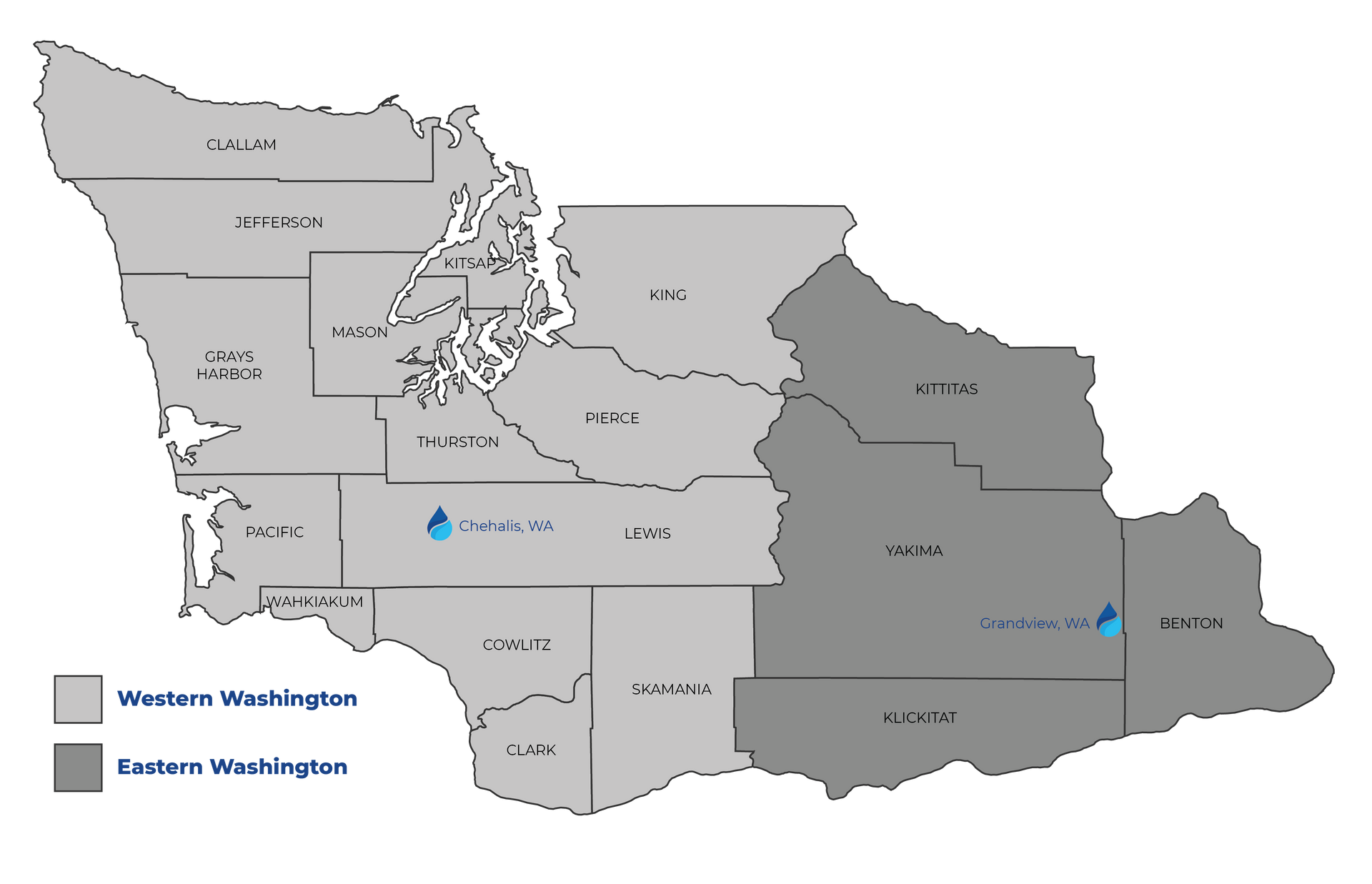New Paragraph
Contact Us
Get the info you're looking for right now
Thank you for considering Water Doctor of Washington for your water treatment and plumbing needs. We are committed to providing top-quality services and making a difference in the lives of our customers. If you have any questions or would like to schedule an appointment, we are here to help. Please don't hesitate to contact us using the information and form provided on this page. We look forward to hearing from you and helping you with all your water treatment and plumbing needs.
Common Frequently Asked Questions
General Equipment FAQs
-
How do I bypass my softener?
Depending on the age of your unit the processes may vary in regards to bypassing your system.
**Always bypass your system whenever you have work performed on your well.
Older style (systems installed prior to 1990) 3-valve bypass
- Turn both blue valves clockwise (one on left and one on right) this closes the valves to & from the softener.
- Turn red valve (center) counter clockwise, this opens the valve between the two blue valves, allowing water to flow.
- This will turn water off to and from unit while still providing water to the house. The water to the house will be untreated, but you will have water.
Lever Bypass
- This will be the same basic set-up as the 3-valve bypass; it will only be in different configurations. Each home or business has unique plumbing schematics, but generally if you look for the inlet and outlet to the softener, you will be able to identify the shut off valves.
- Turn handled levers to off position (perpendicular to the plumbing) that are on the inlet and outlet side of the softener.
- Turn the center valve to the opposite position of normal. This could be a turn style hose valve or another lever style valve. This valve will be close to the inlet and outlet shut off valves, but not directly on the inlet or outlet plumbing. It should be in an area that connects the two.
Kinetico Bypass
- There is a view-able window or cut out to indicate position.
- Turn handle to:
- Green-soft water
- Yellow-bypass
- Red- no water
-
How do I manually regenerate my Kinetico Water Softener?
Using a Phillips screwdriver, apply pressure down to the softener valve center screw. This is located on the clear plastic cap dead center on top of the black valve head. Turn the screw clockwise until your hear three to four clicks and water flowing through the lines. Remember to apply pressure while turning clockwise. Repeat the manual procedure after the water flow stops to be sure that both resin tanks are regenerated.
K5 Drinking Station FAQs
-
How do I change filters on my K5 Station?
The middle canister is your R/O membrane (Do not remove). Normally you would change all filters, other than the membrane.
-
How do I change my Reverse Osmosis filters?
- Turn off the water supply to the drinking water system. This will be either a saddle valve on plumbing system or a shut off valve on the plumbing. For newer systems, the shut off valve is typically white with a blue turn knob.
- Open a faucet to relieve any pressure in the plumbing lines.
- Turn off the water with the valve at the top of the pressure tank.
- Turn filters ½ turn counter clockwise and then pull down. You may need to pull with some effort.
- Prepare the filters for installation. Remove the packaging and fill the new filters with tap water. This step helps minimize air from entering the system.
- Insert new filters; press them up and turn ½ turn clockwise. Be sure to pay attention to the color indicated on your filters and only replace like colors with new colored filter. For example, replace the orange filter with another orange filter only! DO NOT REMOVE THE CENTER MEMBRANE!!! *Note: filters should be secure, if not repeat step 6.
- Slowly turn water back on at inlet supply line and at storage tank.
- Check for any leaks around filters, tank, and any/all connections.
Enjoy your clean, pure, safe drinking water and cost savings of not having to buy bottled water!
*Note: We suggest emptying the tank after the first refill because the water may be discolored with activated carbon dust.
-
How often should I change my filters?
Every 500 gallons or approximately once a year, if you haven’t changed the filters by year 2, we recommend you change them regardless of usage. The post filter on certain Kinetico Premier R/O systems automatically measures water use and alerts you when it’s necessary to change the system’s filter cartridges. The flow of water will significantly be reduced once the 500 gallon threshold is met.
Brine Tank FAQs
-
Why is my brine tank clogged?
Manufacturers rinse the salt crystal before packing them for sale to remove this dirt, but some debris will remain in the crystals and make its way into the brine tank of the water softener. This small amount rarely causes problems with the system on a daily basis. Nevertheless, if the system runs low on salt, issues arise. The dirt present in the salt crystals typically makes its way to the bottom of the tank where it remains. If the tank runs low on salt, however, the addition of more salt stirs up this dirt. It could then make its way into the brine float assembly and become lodged in the shut-off float. If the brine tank overflows, please contact us for service. One tiny piece of dirt could interfere with the proper operation of the shut-off float. If the float doesn’t activate, water continues to enter the brine tank until it overflows. This can then lead to damage to the home. Call out: Kinetico uses 50-75% less salt than conventional water softeners.
-
Do I need to clean my brine tank?
Clean the wall of the brine tank when adding salt. Never overlook this step, as you must remove the dirt and debris, or they will lead to system issues.
Pay close attention to the waterline, as this is
where the dirt and debris often accumulate. If the floating dirt remains in the tank, it makes its way to the bottom of the tank. The system may then draw it into the water softener control valve, or the brine float shut off. This could lead to failure of the brine float shut-off or it might completely stop operation of the water softener. This happens when dirt becomes lodged in the gears of the control valve. Manufacturers balance these gears before putting the system up for sale. If the gears and impellers cannot spin freely, the system cannot operate. This could cause damage to the water fixtures of the home because of hard water build up. In addition, the hot water heater could sustain damage because of a permanent build up in the heater. This brings about expensive repair bills.
-
How often should I change my filters?
Every 500 gallons or approximately once a year, if you haven’t changed the filters by year 2, we recommend you change them regardless of usage. The post filter on certain Kinetico Premier R/O systems automatically measures water use and alerts you when it’s necessary to change the system’s filter cartridges. The flow of water will significantly be reduced once the 500 gallon threshold is met.
Water Heater FAQs
-
Why is there a water leak under my water heater?
Water Dripping From The Top
Water Leaking From The Bottom
Leaking Pipes
If you notice water around the water heater or dripping from the water heater, you’ve got a leaking water heater. If the water is leaking from the bottom of your water heater, this usually means there is a crack in the internal tank and you will need a water heater replacement.
Sometimes a water heater can develop a leak from the top, this is usually caused by a fitting or a plumbing part that has malfunctioned. In this case, the water heater can most often be repaired.
-
Why do I not get enough hot water or as much hot water as I used to?
Not able to enjoy a steaming hot bath any more or is there not enough hot water to last a full shower? Running out of hot water is never any fun and it can be caused by a few different issues.
On a gas water heater, the gas control valve (thermostat) could be broken. For an electric water heater, one of the electric elements or thermostats could have burned out.
The dip tube inside the water heater could be bad, causing a reduced flow of hot water through your pipes.
If your water heater is old (8+ years) or if you live in an area with hard water your water heater could be full of sediment. This will reduce the amount of hot water a water heater can make.
If you are new to the residence the tank may be undersized for your needs or smaller than the water heater in your previous home.
Your hot water needs / habits may have increased over time.
There could be Sediment buildup.
Generally as a water heater ages and nears the end of it’s useful life, it will produce less and less hot water.
Most often this is caused by sediment building up inside the tank. Sediment build-up will decrease the amount of hot water your water heater can produce. Usually the water heater will be noisy or tend to make a loud rumbling sound if sediment is the problem.
Sometimes the sediment can be flushed out of the water heater to fix the problem, sometimes it can not and replacing the water heater may be the only solution.
Malfunctioning Parts
A faulty or bad part can also be the source of not enough hot water. Over time or due to a manufacturing error a part can wear out, but most often they can easily be replaced to get your water heater working at top efficiency again.
A highly trained Water Heaters Only, Inc. technician can diagnose the problem with your water heater and let you know exactly what the solution is. Most often we have the parts available to fix or replace your water heater right away.
-
Why does my water heater make a “rumbling” noise?
Having a noisy water heater is mostly a nuisance, but it could also mean a problem is present. As water heaters age sediment accumulates at the bottom of the tank, this is especially true if the water heater has not been drained on a regular basis. The noise described as “rumbling” usually is the sound of expanding heated water escaping from sediment at the bottom of a tank. This situation is not dangerous, but it is a sign that the water heater has lost much of it’s efficiency.
As sediment builds up, more and more heat is lost up the chimney and less heat gets into your water. The overheating of the bottom of the tank also shortens the life of the tank and can lead to the failure of the water heater. Certain areas are notorious for “bad” water and in these areas flushing the water heater can extend it’s life and save on energy costs. However once sediment is allowed to build up and solidify (It is similar to coral) it can be almost impossible to remove from residential model heaters. To prevent this solidification a homeowner can flush the water heater periodically. If the sediment can be flushed out, it should fix the problem. If not it may be time to replace your water heater.
A high pitched noise from your water heater can be the result of high incoming water pressure. This can be a problem and should be diagnosed and repaired as quickly as possible. Water heaters are designed with a temperature / pressure relief safety valve. This valve is designed to open and release water when the temperature is too high or if there is an excess build up of pressure inside the tank. If for some reason this valve fails to open and the water heater is over pressurized this should be addressed. Long term excess pressure in the water heater or plumbing system can lead to leaks, cracks and in very rare cases a burst water heater.
-
Are there financing options?
There sure are! Water Doctor of Washington is proud to partner with Salal Credit Union. Give us a call for more information!
Send Us A Message
Contact Us
Thank you for contacting us. You will receive a letter and/or an email containing all of the details concerning your SMP within 10 business days. If you have any questions in the meantime feel free to call or text us at 360-748-6393. We appreciate your business and look forward to serving you.
Please try again later
Give Us A Call
Established in 1965 as Rainwater, and later as Water Doctor in 1997, our company has a long-standing tradition of serving the community. In 2023, we combined to form Water Doctor of Washington. As a local, family-owned business headquartered in Chehalis, WA, we are your trusted source for water treatment and plumbing solutions in Washington State.



